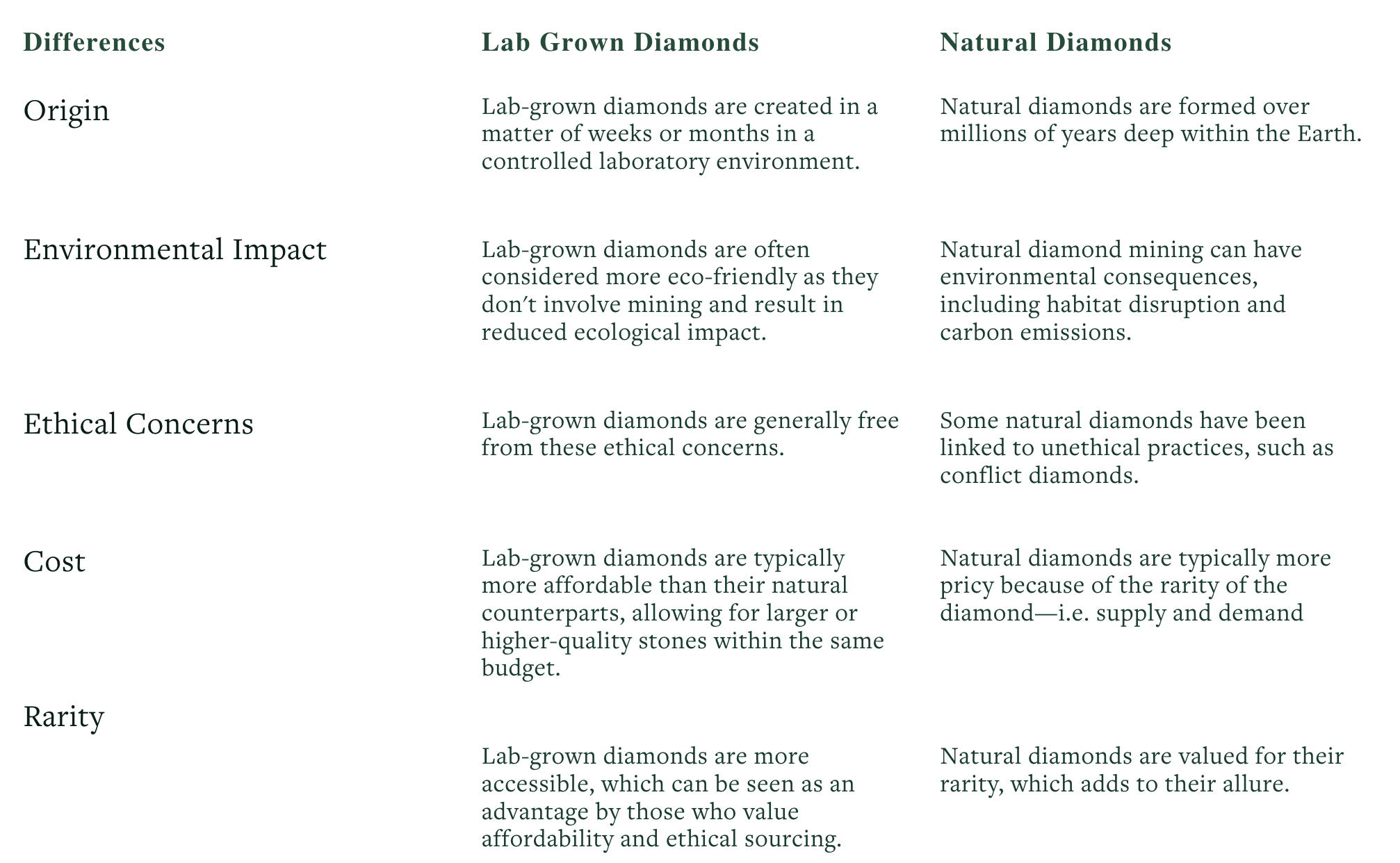Understanding Lab Grown Diamonds
In recent years, there has been a remarkable shift in the diamond and jewelry industry with the emergence of lab-grown diamonds. In this blog post, we'll delve into what a lab-grown diamond is, highlight the similarities and differences between lab-grown and natural diamonds, and explore the shifting landscape of consumer and industry acceptance.
Introduction: A Diamond's Sparkling Evolution
For centuries, natural diamonds have symbolized love, elegance, and enduring beauty. They've adorned engagement rings, graced red carpets, and been cherished as heirlooms. However, in recent years, a remarkable transformation has been taking place in the diamond industry. Enter lab-grown diamonds, a fascinating innovation that's challenging long-standing conventions and giving rise to new choices for consumers.
What is a Lab-Grown Diamond?
Lab-grown diamonds, also known as synthetic or man-made diamonds, are precisely what their name suggests: diamonds created in a controlled laboratory setting. They are formed using advanced technological processes that replicate the natural conditions under which diamonds are created deep within the Earth's crust. These processes mimic the immense heat and pressure necessary for diamond formation, resulting in gems that share the same crystalline structure and exceptional brilliance as their natural counterparts.
Similarities of Lab-Grown Diamonds and Natural Diamonds
Lab-grown diamonds and natural diamonds share several similarities, making it challenging to distinguish them without specialized testing.
Chemical Composition: Both lab-grown and natural diamonds are composed of carbon atoms arranged in a crystalline structure, which gives them their exceptional hardness and brilliance. The chemical composition of lab-grown diamonds is virtually identical to that of natural diamonds.
Physical Properties: Lab-grown diamonds exhibit the same physical properties as natural diamonds. This includes their hardness on the Mohs scale (a rating of 10, making them the hardest natural substance), high refractive index, and the ability to disperse light into the colorful flashes known as fire.
Brilliance and Fire: Both lab-grown and natural diamonds have the same potential for exceptional brilliance and fire due to their similar crystal structures. When well-cut, these diamonds can sparkle with a dazzling play of light and color.
Durability: Lab-grown and natural diamonds are equally durable and resistant to wear and tear. This durability makes them suitable for daily wear in various jewelry settings.
Variety of Cuts and Styles: You can find lab-grown diamonds in a wide range of cuts and styles, just like natural diamonds. This means you have the flexibility to choose the shape and design that best suits your preferences.
Gemological Grading: Both lab-grown and natural diamonds are subject to the same gemological grading criteria, including the 4 C's (carat, cut, color, clarity). This allows for standardized quality assessment and pricing.
Learn more about the four essential characteristics that determine its unique brilliance and value–the 4 C’s: Carat, Cut, Color, and Clarity.
Uses: Lab-grown and natural diamonds are used for the same purposes, including engagement rings, jewelry, industrial applications (due to their hardness), and in scientific and technological research
Differences Between Lab-Grown Diamonds and Natural Diamonds
While lab-grown diamonds closely resemble natural diamonds in their chemical and physical properties, there are key distinctions that set them apart.
Consumer and Industry Acceptance
The acceptance of lab-grown diamonds is on the rise, both among consumers and within the jewelry industry. As ethical and environmental concerns gain more prominence, lab-grown diamonds offer a sustainable and guilt-free alternative. They have also made waves in the bridal jewelry market, with an increasing number of couples choosing lab-grown diamonds for engagement rings.
Major jewelry brands and retailers are now offering lab-grown diamond options alongside natural diamonds, marking a significant shift in the industry. This choice empowers consumers to make informed decisions based on their values, budget, and preferences, as both offer their own distinct beauty and charm.
Conclusion
Lab-grown diamonds represent a remarkable evolution in the world of fine jewelry. Their increasing acceptance signals a promising future for this innovation, as consumers seek both the beauty of diamonds and the assurance that their choices align with their ethical and environmental values. Whether natural or lab-grown, the allure of diamonds remains as brilliant as ever, albeit with new facets to explore.
Learn more:




